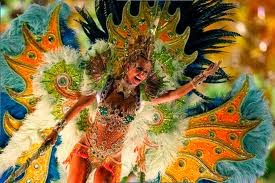Samba is one of the most popular dance. Samba is a lively, rhythmical dance of Brazilian origin in 2/4 time danced under the Samba music. The dance simply follows the beat of the music and can go from average pace to very fast. Men dance with the whole foot on the ground while women, often wearing heels, dance just on the balls of the foot. Professionals may change the steps slightly, taking 4 steps per measure instead of 3, and often add various arm movements depending on the mood of the music.Samba has a very specific rhythm, highlighted to its best by characteristic Brazilian musical instruments. Now it moderately popular ballroom dance, limited pretty much to experienced ballroom dancers because of its speed. More than 20 different types of samba in BrazIl.
Such as- Samba Pagode ,Samba Axé, Samba Reggae, Samba-rock, Samba de roda etc.
Samba, an old
Brazilian style of dance with many variations, is African in origin. It has
been performed as a street dance at carnival, the pre-Lenten celebration, for
almost 100 years. Many versions of the
Samba (from Baion to Marcha) are
danced at the local carnival in Rio . The ballroom Samba or Carioca Samba is derived from the
rural "Rocking Samba" and has been known for many years. (The Carioca
is a small river that runs through Rio de Janiero - hence the name Carioca
refers to the people of Rio .) Today Samba is still very popular in Rio . During
carnival time there are "schools of Samba" involving thousands of
elaborately-costumed dancers presenting a national theme based on music typical
of Brazil and Rio in particular.
Introduced in
1917, the Samba wasn't adopted by Brazil Brazil
Samba has a very specific rhythm, highlighted
to its best by characteristic Brazilian musical instruments: originally called
tamborim, chocalho, reco-reco and cabaca. Much of Samba music came from daily
life in Rio , the first famous example being "Pelo
Telefone" composed by Donga. To achieve the true character of the
Samba a
dancer must give it a happy, flirtatious and exuberant interpretation. Many
figures, used in the
Samba today,
require a pelvic tilt (Samba tic) action. This action is difficult to
accomplish, but without it the dance loses much of its effect. Principal
characteristics of the
Samba are
the rapid steps taken on a quarter of a beat and the pronounced rocking motion
and sway of the dancing couple.
Samba music,
with its distinctive rhythm, is highlighted by original Brazilian musical
instruments, including the tamborim, chocalho, reco-reco and cabaca. Samba is
danced to music with a tempo of about 100 beats per minute. The fast and
energetic rhythm of Samba music encourages spontaneous dancing, such as in the
streets during a Carnival celebration The major action of Samba, the
"Samba Bounce Action," gives the dance its unique look and feel. The
Samba Bounce Action is a gentle, rhythmic action felt through the knees and
ankles. Samba dancers must strive to make this action appear effortless and
carefree...it should never be exaggerated. This bounce action is quite
difficult to master, but really adds to the overall character of the Samba.
Before Samba became a ballroom dance style, there were many styles of partner
dances as well as solo Samba dances. As with the solo Samba, partner ballroom
Samba has a quick beat that requires fast footwork. Over the years, the Samba
has incorporated elaborate tricks, turns, and acrobatic feats into its basic
set of figures. The main characteristics of the Samba are rapid steps taken on
quarter beats and a rocking, swaying motion of the dancers.
The Samba (also known as the Brazilian Waltz) is now
a moderately popular
ballroom dance, limited pretty much to experienced ballroom
dancers because
of its speed. 

No comments:
Post a Comment